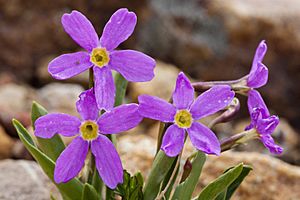Alpine primrose facts for kids
Quick facts for kids Alpine primrose |
|
|---|---|
 |
|
| Scientific classification | |
| Genus: |
Primula
|
| Species: |
angustifolia
|
The alpine primrose (Primula angustifolia) is a beautiful flowering plant. It belongs to the Primulaceae family. You can find it growing naturally in the Rocky Mountains of the United States. It's especially common in Colorado and New Mexico.
What Does it Look Like?
The alpine primrose is a very small plant. It usually grows only 1 to 7 centimeters (about 0.4 to 2.7 inches) tall. Its leaves are shaped like a spear or a spoon. They are slightly folded and measure 2 to 5 centimeters (about 0.8 to 2 inches) long.
This plant can grow as a single stem. Sometimes, it forms small groups or clumps. Its flowers are quite striking. They have a small notch at the tip of each petal. The colors can be pink, lilac, or even a deep purple. Each flower has a bright yellow center, like an eye.
The flowers can be up to 20 millimeters (about 0.8 inches) wide. This can make them look very big compared to the tiny plant! Alpine primroses can vary in size. They also differ in how many flowers they have. Their flower colors can change too. For example, you might find white flowers mostly in New Mexico. This plant blooms during the summer months, from June to August.
Where Does it Live?
The alpine primrose lives in the Rocky Mountains. You can find it in Colorado and the northern parts of New Mexico. It prefers very high places. This plant usually grows above the tree-line. This means it lives where trees can't grow because it's too cold or windy. It likes rocky areas. You'll often see it at altitudes higher than 3,000 meters (about 9,842 feet). This type of environment is called tundra.
How Can We Grow It?
People sometimes grow the alpine primrose in gardens. It can live for a long time when cared for. This plant produces many flowers. However, it rarely makes seeds.
It grows best in containers. These containers are often kept in a greenhouse. A good soil mix for it is rich and sandy. Some people have had success growing it outdoors. For example, it has grown well in Scotland. There, it was planted in special outdoor containers called troughs.
See Also

